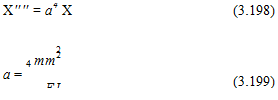Equation of Motion
From Section 2.3.2, Eq. (2.53) is repeated here for convenience
In the following sections, we treat the special case of free vibration for which
f (x, t) = 0.
3.3.1 General Solutions
A solution to the equation of motion for the transverse vibrations of beams can be obtained by a separation of the independent variables. This separation is denoted as
v(x, t) = X(x)Y(t) (3.195)
which, when substituted into the equation of motion, yields
![]() (EIX")" Y
(EIX")" Y
mX = – Y
Because the dependencies on x and t were separated across the equality, each side must equal a constant—say, m2. The resulting ordinary differential equations then become
![]() (EIX")" – mm2X = 0 Y + m2 Y = 0
(EIX")" – mm2X = 0 Y + m2 Y = 0
For simplicity, we specialize the equations for the case of spanwise uniformity of all properties so that the first of Eqs. (3.197) simplifies to
 where
where
is a constant.
For a = 0, the general solution to the second of Eqs. (3.197) can be written as in the cases for the string and beam torsion; namely
Y(t) = Asin(mt) + B cos(mt) (3.200)
For a = 0, the general solution to the spatially dependent equation can be obtained by presuming a solution of the form
![]() X(x) = exp(Xx)
X(x) = exp(Xx)
Substitution of this assumed form into the fourth-order differential equation for X(x) yields
X4 – a4 = 0 (3.202)
which can be factored to
(X — i a)(X + i a)(X — a)(X + a) = 0 (3.203)
indicating a general solution of the form
X(x) = C1 exp(iax) + C2 exp(—iax) + C3 exp(ax) + C4 exp(—ax) (3.204)
Rewriting the exponential functions as trigonometric and hyperbolic sine and cosine functions yields an alternative form of the general solution as
X(x) = D1 sin(ax) + D2 cos(ax) + D sinh(ax) + D4 cosh(ax) (3.205)
Eventual determination of the constants Di (i = 1, 2, 3, and 4) and a requires specification of appropriate boundary conditions. To facilitate this procedure, this last solution form can be rearranged to provide, in some cases, a slight advantage in the algebra, so that
![]() X(x) = £1[sin(ax) + sinh(ax)] + E2[sin(ax) – sinh(ax)]
X(x) = £1[sin(ax) + sinh(ax)] + E2[sin(ax) – sinh(ax)]
+ E3[cos(ax) + cosh(ax)] + E4[cos(ax) – cosh(ax)]
To complete the solution, the constants A and B can be determined from the initial deflection and rate of deflection of the beam. The remaining four constants, Ci, Di, or Ei (i = 1,2,3, and 4), can be evaluated from the boundary conditions, which must be imposed at each end of the beam. As was true for torsion, the important special case of a = 0 is connected with rigid-body modes for beam bending and is addressed in more detail in Section 3.3.4.











